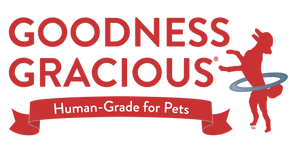Is Kibble Bad For Your Dog’s Teeth? A Must-See Video, Plus 3 Ways to Clean Those Canines

You'll want to watch this veterinarian's video experiment on what kibble can do to your dog's dental health. Then we share three fun and flavorful ways to clean those canines!
Imagine sitting in the dentist chair for a regular cleaning and being handed a granola bar. Crunching on kibble is about as effective at cleaning your dog’s teeth as that granola bar is for yours!
Your dog’s teeth are just as important as your own. And while it might be tough to get that toothbrush into a moving target, there are some very effective and pleasant alternatives for maintaining your dog’s pearly whites!
Dogs and Oral Health
When it comes down to it, painful mouth conditions are among the most common reasons for vet visits. Gum disease is caused by plaque that’s not removed and hardens into tartar. Tartar irritates the gums and inflames them – a problem called gingivitis. Gums recede from the teeth and cause little pockets where bacteria can grow. Periodontal disease develops which involves things like loose or decayed teeth and infections.
These oral infections have been linked to cardiovascular problems like inflammation of the heart (aka endocarditis), thickening of artery walls and blood clots. Oral inflammation also contributes to oral cancers. So, what are some best practices that you can take as a pet parent to ensure your dog’s dental health is supported each and every day?
Diet Is The #1 Preventative
There’s nothing like stopping the problem before it starts, and most kibble is where it begins. What’s our beef with kibble? Let’s just say, we wouldn’t have one if it actually contained appropriate amounts of quality beef. Normal, healthy dogs do best on high protein diets.
Most kibble – from the budget brands to the super-premium pet food is loaded with starchy carbs and starch is anathema to healthy teeth and gums in dogs. Dogs do not produce the enzyme amylase needed to break down starch; as a result plaque builds up and starts the cascade of health problems mentioned above.
To prove the point that starchy kibble is bad for teeth, Dr. Tom Lonsdale, DVM conducted an experiment in his practice and posted a YouTube video. He recruited four young dogs with pristine teeth, gums and fantastic health. He fed them kibble (Science Diet) for 17 days and during that time he watched the teeth of all four dogs turn from pearly white to yellow, their gums turn from a bubblegum pink to an inflamed and bloody red, their breath turn from healthy to malodorous, and their stools morph from perfect to problematic.
The Importance of a Species Appropriate Human Grade Diet Containing Chewy or Chelating Components
A species appropriate balanced diet according to Dr. Nate Heilman, DVM is one that limits starches to a range of 0% - 15%. That’s right: as low as zero. In his practice, starches are included in diets in the winter months when dogs may need a little boost, or in the diets of dogs that may be energetically deficient or imbalanced from a eastern medicine perspective.
Finding a commercially prepared diet that meets this starch requirement can be tough. There are some good choices, however, for USA made and sourced, high-protein, human edible dog treats, and pet foods made with human grade ingredients that fit the bill. Or you can make your own, following the guidance of Dr. Heilman and some recipes posted here like this one make with turkey (or cod), broccoli and strawberries.
No One Chases a Wolf Around the Woods with a Toothbrush
Dogs can do a decent job maintaining their own oral health if the cards are not stacked against them with a starch-laden diet. To do this, dogs chew and gnaw on species appropriate food items like large bones, a frozen chicken carcass, or dehydrated human grade single-ingredient beef tendons. The chewing and gnawing action is akin to the scrubbing, chelating and massaging action of brushing; it helps remove the plaque and tartar from the teeth and improve circulation to the gums. Plus it increases salivation which counteracts the bacteria in the mouth.
Brushing and Regular Dental Checkups
You know the saying: an ounce of prevention is worth a pound of cure. Most vets recommend brushing your dog’s teeth every one to two days. Canine toothpaste, while recommended, is not necessary. Especially if it gets in the way of compliance. One thing is certain: do not use human toothpaste when brushing your dog’s teeth. Many products intended for humans contain xylitol which is toxic to dogs.
When your dog reaches a certain age, she may need to have her teeth professionally cleaned. The procedure requires anesthesia and involves a power-washing device used by an experienced veterinary technician or veterinarian. It is an out-patient procedure. Imaging is usually done at this time too, to check for any teeth that may need to be extracted.
Goodness Gracious Can Help
There you have it. Three big things to keep your dog's mouth healthy are: a species appropriate diet that's limited in starch, healthy high protein chews and bones, and regular brushing and checkups.

Here at Goodness Gracious, we make human grade treats like our single-ingredient beef tendon chews for dogs that can help keep your dog's teeth in good health. We call them Gnarlies and dogs dig them. I love watching my dogs entertain themselves with these species appropriate, odor-free dental treats. Clean teeth, healthy gums, fresh breath. What’s not to love. Now give me a smooch.
References: https://healthypets.mercola.com/sites/healthypets/archive/2020/01/29/dog-oral-health.aspx


